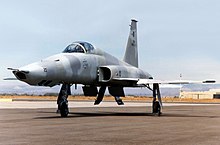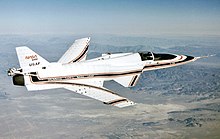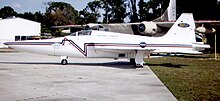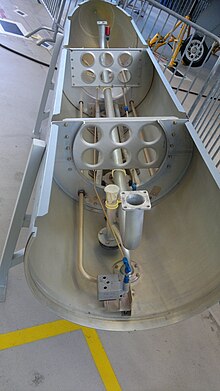Northrop F-5
| Northrop F-5 Freedom Fighter / Tiger II | |
|---|---|
 An F-5E "Tiger II" of the Iranian Air Force |
|
| Type: | Light fighter aircraft |
| Design country: | |
| Manufacturer: | |
| First flight: |
July 30, 1959 |
| Commissioning: |
1962 |
| Production time: |
1962 to 1987 |
| Number of pieces: |
2238 |
The Northrop F-5 Freedom Fighter and the F-5E Tiger II developed from it have been twin-engine fighters developed and built by Northrop in the United States since the 1950s . For up worldwide today use, including in the aerobatic squadrons Patrouille Suisse and Turkish Stars .
history
From 1950 onwards, Northrop investigated in numerous studies innovative design options and marketing prospects for a lightweight fighter aircraft that was to be used primarily by smaller states allied with the USA in Asia and Europe. The driving force behind Northrop was the company's new Vice President, Edgar Schmued, who had already been responsible for the design of the North American P-51 Mustang. The studies divided the costs into research and development, procurement and operating costs, with Northrop showing that the latter represented the largest proportion. Above all, the size of the aircraft, which is proportional to the operating costs, its weight and the system complexity should be reduced.
The first draft was the N-102 Fang , but it quickly became clear that when using the engines of that time with a flight mass between 6800 and 8165 kg, the goal of a light fighter aircraft could not be achieved. In 1954 a mock-up of the catch was made, but further work was stopped shortly afterwards.
N-156T
The next construction work on a lightweight fighter began in 1955 under the designation N-156. The weight reduction was mainly due to the availability of the small General Electric J85 engine. The original YJ85 did not have an afterburner and delivered a thrust of only 9.34 kN, but Northrop's plans were based on an afterburner version with 17.3 kN thrust promised by General Electric. The N-156 went through some very different stages of development. In March 1955, the two-seater N-156TX Tally Ho made the start, with two engines in under-wing nacelles. Then the N-156NN followed in November 1955 as a naval fighter, which was designed similar to the Grumman F9F Panther and was to be used on accompanying carriers. For 1956, six designs that were not pursued further are known before the single-seat N-156F and the two-seat N-156T were finally chosen as the final concepts for wind tunnel studies.
The relatively low maximum speed of the design of Mach 1.5 was below that of enemy fighters at the time and contributed significantly to the resistance to Northrop's construction. However, the company pointed out that although the cell could handle an increase of Mach 0.3, the focus was on improving reliability, maintainability and operating costs. Northrop decided to focus on the two-seater version first, as this was where they saw better marketing opportunities. The N-156T was developed to such an extent that it was able to take part in the USAF General Operational Requirement SS-240L competition for a supersonic trainer aircraft as a Lockheed T-33 replacement in 1955. In June 1956 the US Air Force (USAF) commissioned the construction of three prototypes under the designation YT-38 . The last one was intended as a static break cell. Difficulties in developing the afterburner version of the J85 led to delays in the first flight of the T-38. Finally, this took place on April 10, 1959 with the YT85-1 afterburnerless delivering just 8.45 kN.

N-156F
Although the N-156F could theoretically have been equipped with the Pratt & Whitney J60 or the Rolls-Royce RB.145 or RB.153 engines, the single-seater also used the YT85-1. The N-156F retained the maximum possible correspondence with the T-38, so that the T-38 dummy could be converted into the fighter version at short notice. Since this was still a private venture project, Northrop tried to keep the changes as small as possible. However, the N-156F had larger air inlets in order to be able to use more powerful engines with a larger mass flow later, a modified splitter plate to separate the boundary layer near the fuselage in the air inlet, as well as an extended LERX . Slats were also introduced.
The US Department of Defense approved Northrop on 25 February 1958 under the FX -Programms 32 million US dollars to build three prototypes and a broken cell. The aim of this program was to develop a counter-air fighter aircraft that would be delivered to countries benefiting from the Military Assistance Program (MAP). The aircraft was named Freedom Fighter . After the roll-out on May 31, 1959, the first flight followed on July 30 of the same year, four months after the YT-38. Test pilot Lew Nelson already reached supersonic speed on the first flight. Despite the excellent results of the flight tests carried out with two prototypes, the USAF decided in August 1960 that there was no immediate need for this class of aircraft. Without this USAF confirmation, Northrop saw no chance of being able to market the N-156F. The program was then canceled and the third prototype was not completed.
F-5A


In 1962, interest in N-156F reawakened. President John F. Kennedy announced that he would pay “any price” for the preservation of freedom and victory over communism . This included the provision of funds to procure advanced fighters for the US allies. The USAF remained skeptical about the N-156F, as it preferred variants of the Lockheed F-104 Starfighter (F-104-17 or F-104H) and the Vought F8U Crusader for these purposes. The US Army , however, showed interest and borrowed from the prototype that provided them with the full standard paint the Army and for their procurement program of Luftnahunterstützungs - fixed-wing aircraft in a very successful for the N-156F comparison flights against the Fiat G.91 and Douglas A4D Skyhawk began .
However, the USAF insisted on its prerogative to provide jet aircraft for close air support and put pressure on the Army to do so, which then discontinued the comparison competition. While the Army continued to use helicopters in this role, the USAF's interest in the N-156F was renewed. On April 23, 1962, the Secretary of Defense officially confirmed that the N-156F met the requirements of the FX program; on August 9, 1962, the aircraft received the USAF designation F-5. The three prototypes were retrospectively given the designation YF-5A, while the fracture cell, unusually XF-5A, also received a USAF designation. In October 1962 an order for $ 20 million was placed to start production. A ratio of 9: 1 should be maintained between the single-seat F-5A and the two-seat F-5B.
The previously unused XF-5A was the first new aircraft to be completed in the series configuration with two J85-GE-13s, each with 18.15 kN. The previous USAF serial number 59-4993 of the machine actually intended as a break cell has been changed to 63-8367. The most important improvement of this first F-5A was the reinforced wing, which now had two additional external load stations, increasing their total number to seven, including the wing tips. The two N-156F prototypes were brought to the same standard. During testing, a second order followed on August 27, 1963, bringing the total - including the two-seater trainers - to 170 aircraft. Between February and October 1964, barrel weapons in the form of two 20-mm Colt-Browning M39 cannons were installed and tested in the upper part of the fuselage for the first time .
The first customer of the F-5A was Norway, which announced its acquisition of 64 aircraft in February 1964. These F-5A (G) also received a heated windscreen, a landing hook and devices for JATO starts. The USAF took over the first F-5A in January 1964 without cannon armament and from August 1964 they were used at the 4441st Combat Crew Training School (CCTS) at Williams Air Force Base.
Other states that received these new hunters included South Vietnam . There the F-5A demonstrated its effectiveness on the border with North Vietnam (from 1965 to 1967 partly with USAF markings in the so-called “ Skoshi Tiger ” project). During the fighting in Vietnam, the Freedom Fighter was nicknamed "Tiger". After the Biên Hòa airfield was overrun in the Battle of Xuan Loc in 1975 , North Vietnamese pilots took over the machines and used them against the South Vietnamese army . The Democratic Republic of Vietnam later received more copies from Thailand, where numerous South Vietnamese pilots fled with their planes.
F-5B
The two-seater F-5B connected the tandem cockpit of the T-38 with the airframe of the F-5A, whereby their external load stations, the LERX and the larger air inlets, were retained. The automatic cannons were not taken over, however. The prototype made its maiden flight on February 24, 1964. The first five F-5Bs were taken over by the 4441st CCTS in April 1964, where seven F-5A were added in August. Although operated by the USAF, the CCTS was only used to train pilots and ground crews from customer countries. In March 1965 the first training course with pilots from Iran and South Korea was completed. The aircraft of the 4441st CCTS carried USAF markings, but they actually belonged to the respective MAP states.
The F-5B differs from the T-38 in the following ways:
- Wing pylons for weapons
- Sidewinder pylons on the wing tips
- fixed centerline pylon
- IFF
- LERX (Leading-Edge Root Extensions) - Extension of the leading edge of the wing between the wing root and the engine inlets
- Braking parachute
- reinforced chassis
- most of the specimens have a catch hook
Variant overview
- XF-5A
- Static fracture cell, which was unusually given both a USAF designation and a serial number.
- YF-5A
- Retrospective designation for the three N-156F prototypes
- F-5A
- Production for the MAP program
- CF-5A
- F-5A built by Canadair (factory designation CL-219) for the Canadian Air Force . With a Canadian Orenda engine with 150 kp more thrust, rigid air refueling probe on the right.
- NF-5A
- built by Canadair for the Dutch Air Force . With new radar, moving map, larger drop tanks, computer-controlled slats and flaps for better maneuverability.
- RF-5A
- Photo reconnaissance version of the F-5A with modified fuselage bow. Equipped with four bow cameras for limited combat capability. Just an on-board cannon, no radar.
- SF-5A
- Built by CASA for the Spanish Air Force . Spanish name C9
- VF-5A
- Unofficial name of the Venezuelan F-5A
- F-5B
- Retrospective designation for the N-156B. Two-seat emergency trainer version. Production under the MAP program
- NF-5B
- Built by Canadair for the Netherlands. With new radar, moving map, larger drop tanks, computer-controlled slats and flaps for better maneuverability.
- SF-5B
- Built by CASA for the Spanish Air Force. Spanish name CE9
- VF-5B
- Unofficial name of the Venezuelan F-5B
- F-5C
- Reserved designation for USAF F-5A, but not used. Unofficial name for twelve F-5A, which were used by the US Air Force ( Skoshi-Tiger ) on a trial basis in Vietnam and were equipped with an air refueling probe . They were later given to South Vietnam .
- F-5D
- Reserved designation for the USAF's F-5B. Not used.
- CF-5D
- Canadair (factory designation CL-226) built F-5B for the Canadian Air Force. Sometimes referred to as the CF-5B. With a Canadian Orenda engine with 150 kp more thrust, rigid air refueling probe on the right.
production
Acceptance of the F-5A / B and RF-5A by the USAF
| version | 1964 | 1965 | 1966 | 1967 | 1968 | 1969 | 1970 | 1971 | 1972 | 1973 | 1974 | 1975 | 1976 | TOTAL |
|---|---|---|---|---|---|---|---|---|---|---|---|---|---|---|
| F-5A MAP | 34 | 122 | 113 | 90 | 61 | 12 | 1 | 2 | 2 | 437 | ||||
| F-5A MASF | 33 | 8th | 5 | 4th | 5 | 55 | ||||||||
| F-5A Iran | 24 | 14th | 38 | |||||||||||
| F-5A Libya | 3 | 2 | 4th | 9 | ||||||||||
| F-5A Morocco | 2 | 1 | 9 | 12 | ||||||||||
| F-5A Norway | 1 | 12 | 10 | 23 | ||||||||||
| F-5A Taiwan | 19th | 19th | ||||||||||||
| F-5B MAP | 12 | 16 | 14th | 12 | 9 | 7th | 1 | 1 | 8th | 8th | 88 | |||
| F-5B MASF | 2 | 2 | 2 | 5 | 11 | |||||||||
| F-5B Iran | 2 | 3 | 5 | 10 | ||||||||||
| F-5B Jordan | 2 | 2 | ||||||||||||
| F-5B Korea | 2 | 14th | 16 | |||||||||||
| F-5B Libya | 7th | 1 | 8th | |||||||||||
| F-5B Malaysia | 1 | 1 | 2 | |||||||||||
| F-5B Morocco | 1 | 1 | ||||||||||||
| F-5B Norway | 1 | 1 | 4th | 2 | 8th | |||||||||
| F-5B Saudi Arabia | 14th | 6th | 20th | |||||||||||
| F-5B Taiwan | 4th | 8th | 12 | |||||||||||
| RF-5A MAP | 13 | 6th | 30th | 8th | 57 | |||||||||
| RF-5A MASF | 4th | 6th | 3 | 13 | ||||||||||
| RF-5A Libya | 1 | 1 | ||||||||||||
| RF-5A Morocco | 1 | 1 | ||||||||||||
| RF-5A Norway | 16 | 16 | ||||||||||||
| TOTAL | 46 | 138 | 131 | 139 | 121 | 68 | 99 | 24 | 40 | 16 | 12 | 11 | 14th | 859 |
Further developments
F-5E Tiger II
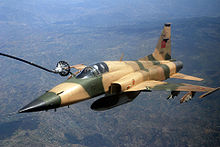
With larger tanks and new engines, the F-5 was renamed the F-5E Tiger II to replace all previous models. Many variants were developed on the basis of this design, including the two-seat F-5F training aircraft and reconnaissance versions. Although it was unsuccessful in its country of origin (the USAF only used 112 F-5E and F, mainly for air combat, tactical training and camouflage testing, the US Navy used a few in the top gun program ), the F-5E was in many countries (for example Ethiopia , Brazil , Chile , Greece , Indonesia , Iran , Yemen , Jordan , Canada , Morocco , Norway , Philippines , Saudi Arabia , South Korea , Switzerland , Taiwan , Thailand , Tunisia , Turkey ) and so became the mainstay many air forces. It is still in use in some countries.
Among other things, Switzerland owns 53 F-5E / F (as of the end of 2018). With the 2018 Army Message, the Federal Council applied for the decommissioning of weapons systems or parts of them that are no longer required on February 14, 2018. This includes 27 of the 53 F-5 Tiger fighter aircraft still in existence at the time. They are to be sold. The remaining 26 aircraft are to continue to be used to relieve the F / A-18 Hornet of secondary tasks, in particular for targeting during training, for monitoring radioactivity or for the Patrouille Suisse aerobatic team . The fleet is to be operated until the end of 2025. From 2004, twelve of the Swiss F-5E's were leased to Austria , where they took over air surveillance as an interim solution until the Eurofighter Typhoon (as Draken's successor) was commissioned . The Swiss Air Force has sold 44 F-5E to the US Navy.
The F-5 was later used by the US Navy as a training aircraft for the fight against opposing forces (Top Gun), as its performance data were comparable to those of the Soviet MiG-21 Fishbed . Since these jets are very cheap to fly one hour, they are still in use today. These machines are flown by pilots specially trained in Soviet combat doctrine and play the "bad guys" in simulated battles. In this role, the F-5 Tiger was also honored in the cinema: In the film Top Gun, the jets simulate the fictional Soviet MiG-28 in the aerial combat scenes. The US Air Force also uses the T-38 Talon variant for pilot training. Practically all US (and also German) jet pilots gather their first supersonic flight experience on this type . Until the Lockheed SR-71 Blackbird was decommissioned , the T-38s were also valued by their pilots for training flights with similar flight characteristics.
The design of the F-5 served as the basis for other, sometimes very successful, aircraft types. The F / A-18 Hornet was developed from the prototype YF-17 Cobra , which was based in part on the F-5 Tiger II . The further development to the single-engine F-20 Tigershark , of which only three copies were built, was not commercially successful .
The Islamic Republic of Iran produces its own version of the F-5 under the name "Saeqeh", which is particularly noticeable on the outside thanks to the double tail unit. Presumably the IRIAF (Air Force of Iran) received 24 aircraft of this type.
Differences to the F-5A:
- automatic wing flap system
- Hiking nose gear
- new LERX shape
- new shape of the UHF antenna cladding on the vertical stabilizer
- flattened radome for a better view to the front and bottom
- Radar warning system (two at the stern, two at the bow and a leaf antenna under the bow)
- Decoys launcher with radar and IR decoys
- No more wing end tanks, but launch rails for AIM-9 Sidewinder (or recording pod)
- new radar and new engines J85-21
RF-5E Tigereye
Identical to the F-5E, but only a 20 mm cannon and no radar, but several cameras in the bow, fully suitable for combat.
F-5F
Identical to the F-5E, but with two seats, only one on-board cannon, stern cockpit (flight instructor). Is not equipped with all instruments (e.g. no optical sighting device), but only with the most important ones, but with the ejection seat selector switch (dual control, single release, etc.). The front cockpit corresponds exactly to that of the F-5E. In the bow, instead of the oxygen bottle for gaseous oxygen (GOX) in the F-5F, a tank for liquid oxygen (LOX) is mounted. The fuselage is 1.08 m longer than the F-5E. The F-5F has a boundary layer fence on each wing . In addition to pilot training, the F-5F are also used as disruptive aircraft. In this case there is an on-board operator on the rear seat who operates the jamming pods (e.g. Vista5). The pods are attached to the inner wing pylons. In addition to these tasks, the F-5F can of course also be used effectively for air defense with just one pilot.
F-5T Tigris
The F-5E flown by the Royal Thai Air Force's 211th Squadron were modernized by IAI between 1999 and 2004. The machines can now also carry the Python guided weapon .
F-5E / F
There is an F-5E / F at the Meiringen airfield in Switzerland - this machine is a conventional F-5E with the wings of an F-5F (boundary layer fence). However, it stayed with this one copy, which is now part of the Battle Damage Repair program. This training hall is also a small museum of the airfield.
F-20 Tigershark / F-5G
The F-5G (later referred to as the F-20) is a radical overhaul of the F-5E. With new avionics , new radar, new cockpit equipment, a Gatling cannon instead of the two revolver cannons (in the final version, the prototype had the same cannons as the F-5E), new air inlets, a new vertical tail unit with cooling air inlet and aerodynamically improved brake screen container. The entire rear fuselage has been redesigned. The F-20 no longer has two engines, but a single, more powerful General Electric F404 GE-400 engine , which is also used in the F / A-18. Northrop built three prototypes of the F-20, a fourth was not completed and it did not go into series production because the US armed forces had chosen the General Dynamics F-16 .
X-29
The X-29 was used by NASA for testing a forward swept wing. When building the two machines, Grumman used assemblies from existing samples as much as possible in order to keep costs down. So one took over from the F-5 (on the F-20 development level) the fuselage bow and the nose landing gear. The main landing gear came essentially from the F-16 and the engine system was taken over from the F-18.
Shaped Sonic Boom Demonstration
The "Shaped Sonic Boom Demonstration" is a modified F-5E with which a shape to reduce the sonic boom was experimented.
Replicas of Iran
Azarakhsh
In September 1997 Iran announced the in-house production of a new fighter aircraft called the Azarakhsh . This type is similar to the American Northrop F-5 that has been supplied to the Iranian Air Force since the 1960s . The Azarakhsh has a number of modified design features, including the shape of the air inlets below the wings and the structure behind the cockpit. It is believed to be equipped with the modern Russian radar Phazotron N019 Topaz (N-019ME). In 2001 Iran owned six aircraft of this type.
Saeqeh
The Iranian Saeqeh (German: "Thunderbolt") fighter aircraft is similar to the Northrop F-5 Tiger, but it has a double vertical tail that is based on that of the US F-18 Hornet . The development was officially announced back in 1998; The first test flights took place in 2001. On September 6, 2006, the Iranian state television IRIB showed a video of the fighter plane for the first time.
Kowsar
In 2018, the series production of an aircraft was to begin, which outwardly corresponded again to the F-5. A modern radar system and modern avionics should be installed.
Technical specifications
| Parameter | F-5E Tiger II data |
|---|---|
| Type | Light tactical fighter aircraft |
| crew | 1 |
| length | 14.45 m |
| span | 8.13 m |
| height | 4.08 m |
| Wing area | 17.28 m² |
| Empty mass | 4,349 kg |
| Max. Takeoff mass | 11,187 kg |
| Max. Fuel capacity | 2563 l (internal) |
| Top speed | Mach 1.64 or 1743 km / h (at optimal altitude) |
| Rate of climb | 10,455 m / min |
| Service ceiling | 15,790 m |
| Use radius | up to 1405 km |
| Range | 3720 km (with external additional tanks) |
| Engines | two General Electric J85 GE-21B jet engines |
| Thrust |
|
| Max. Gun load | approx. 3200 kg |
Armament
- Permanently installed on-board cannons
- 2 × 20 mm Pontiac (Colt-Browning) M39A2 automatic cannons with 280 rounds of ammunition each
- Ordnance for a maximum of 3,175 kg at five external load stations and two wing tip launch rails
- Air-to-air guided missile
- 2-4 × LAU-100 launch rails for 1 × Ford / Raytheon AIM-9B / J / P-5 / L "Sidewinder" - infrared-controlled short-range air-to-air guided missile
- 4 × launch rails for 1 × Raytheon AIM-120 AMRAAM each - radar-controlled medium-range air-to-air guided missile (F-5S only)
- 4 × launch rails for 1 × Hughes AIM-7D "Sparrow" each - semi-active radar-controlled medium-range air-to-air guided missile (F-20 only)
- 4 × launch rails for 1 × Rafael Python-4 each - infrared-controlled short-range air-to-air guided missile (Chilean F-5E / F Tiger II, Brazilian F-5EM)
- 4 × launch rails for 1 × Rafael Derby each - radar-controlled short-range air-to-air guided missile (Brazilian F-5EM only)
- Air-to-surface guided missile
- 4 × LAU-117A starting rail supports for 1 × Raytheon AGM-65A / B "Maverick" each - infrared or television image-guided
- 4 × Martin Marietta AGM-12B "Bullpup" - remote controlled
- Unguided air-to-surface missiles
- 2 × rocket tube launch container LAU-10B / A for 4 × unguided Zuni air-to-ground missiles each ; Caliber 127 mm / 5 inch
- 4 × LAU-3 / A rocket tube launch containers for 7 × unguided FFAR air-to-surface rockets each ; Caliber 70 mm / 2.75 inches
- 4 × Matra F4 rocket launchers for 18 × unguided SNEB air-to-surface missiles each ; Caliber 68 mm
- 4 × TBA 100-4 (F3) rocket launchers for 4 × unguided SNEB air-to-surface missiles each; 100 mm caliber
- Unguided free-fall bombs
- 5 × Mark 81 LDGP (127 kg free-fall bomb )
- 5 × Mark 82 LDGP (227 kg / 500 lb free fall bomb)
- 5 × Mark 82 "Snake Eye" (227 kg free-fall bomb with braking parachute)
- 5 × M117A1 GP (free fall bomb)
- 1 × Mark 84 LDGP (907 kg / 2000 lb free fall bomb)
- 5 × Mark 20 "Rockeye II" (222 kg / 490 lb anti-tank cluster bomb with 247 Mk.118 bomblets)
- 5 × CBU-24 cluster bomb
- 5 × CBU-49 cluster bomb
- 4 × BLU-1 , 340 kg incendiary bomb
- 2 × BLU-27 / B (340 kg / 750 lb napalm B bomb)
- 2 × BLU-32 / B (250 kg incendiary bomb)
- 2 × British Hunting Engineering BL755 (254 kg cluster bomb with 147 bomblets with shaped charges)
- Additional container
- 3 × drop-off additional tanks for 1,050 liters (for 275 gal kerosene; only F-5E / F)
- 3 × 570 liter additional tank (for 150 gal kerosene; only F-5A / B)
- 2 × 190 liter additional wing end tanks (for 50 gal kerosene; only F-5A / B)
- 1 × SUU-20A / A training bomb case
- 1 × Swedish tow winch for tow bag
- 1 × Flight Refueling Limited CBLS 200 training bomb container for 4 training bombs
- 1 × Ericsson Saab Avionics ALQ-503 (EriJammer A100 "Vista-5") - electronic jammer
- 1 × AN / ALQ-171 (V) jammer container
Self defense
- Active measures
A fairing for two decoy launchers is installed under the fuselage behind the starboard main landing gear .
- 2 × US TRACOR AN / ALE-40 (V) 7 flare launchers with 15 flare cartridges each, e.g. MJU-7A / B heat flares with 38 mm width and length or 30 RR-170 flare cartridges with 25 mm width and length (Netherlands, Norway, Saudi Arabia and Switzerland)
- Passive action
Two radar warning receivers are installed on each side behind the radar nose cover and in front of the afterburners.
- 4 × Nortroph Grumman AN / ALR-87 - radar warning receiver (Switzerland / South Korea)
- 4 × Nortroph Grumman AN / ALR-46 radar warning receiver (Saudi Arabia)
- 4 × AN / ALR-69 radar warning receiver (Norway)
Users
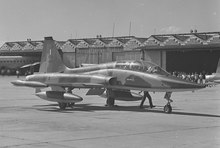
-
 Ethiopia
Ethiopia
-
 Bahrain (8 F-5E and 2 F-5F)
Bahrain (8 F-5E and 2 F-5F) -
 Botswana (10 modernized CF-5A and 5 CF-5D from Canada)
Botswana (10 modernized CF-5A and 5 CF-5D from Canada) -
 Brazil (57 F-5E)
Brazil (57 F-5E) -
 Chile (16 F-5 III Plus, 14 F-5E and 2 F-5F)
Chile (16 F-5 III Plus, 14 F-5E and 2 F-5F) -
 Greece
Greece
-
 Honduras (16 F-5E)
Honduras (16 F-5E) -
 Indonesia
Indonesia
-
 Iran (140 F-5E / F)
Iran (140 F-5E / F) -
 Yemen
Yemen
-
 Jordan
Jordan
-
 Canada
Canada
-
 Kenya (13 F-5E and 2 F-5F from Jordan)
Kenya (13 F-5E and 2 F-5F from Jordan) -
 Libya
Libya
-
 Malaysia
Malaysia
-
 Morocco (33 F-5A / B, 9 F-5E / F and 24 modernized F-5TIII)
Morocco (33 F-5A / B, 9 F-5E / F and 24 modernized F-5TIII) -
 Mexico (10 F-5E and 2 F-5F, service period 1982 to 2016)
Mexico (10 F-5E and 2 F-5F, service period 1982 to 2016) -
 Netherlands (NF-5A, NF-5B)
Netherlands (NF-5A, NF-5B) -
 Norway
Norway
-
 Austria (12 F-5E 2004-2008 rented from Switzerland)
Austria (12 F-5E 2004-2008 rented from Switzerland) -
 Philippines (22 F-5A and 8 F-5B)
Philippines (22 F-5A and 8 F-5B) -
 Saudi Arabia (110 F-5E / F)
Saudi Arabia (110 F-5E / F) -
 Singapore ( RSAF , 32 F-5S, 9 F-5T and 8 RF-5S)
Singapore ( RSAF , 32 F-5S, 9 F-5T and 8 RF-5S) -
 South Korea
South Korea
-
 Spain (20 F-5B)
Spain (20 F-5B) -
 Sudan (10 F-5E and two F-5F)
Sudan (10 F-5E and two F-5F) -
 Switzerland (1st lot: 66 F-5E and 6 F-5F, 2nd lot: 32 F-5E and 6 F-5F), 27 still in use.
Switzerland (1st lot: 66 F-5E and 6 F-5F, 2nd lot: 32 F-5E and 6 F-5F), 27 still in use. -
 Thailand
Thailand
-
 Taiwan (Chung-Hua Min-Kuo K'ung-Chün - Taiwanese Air Force : 115 F-5A / B, and 308 F-5E / F under license)
Taiwan (Chung-Hua Min-Kuo K'ung-Chün - Taiwanese Air Force : 115 F-5A / B, and 308 F-5E / F under license) -
 Tunisia
Tunisia
-
 Turkey (over 200 F-5A / B and NF-5A / B; 40 to 50 upgraded to F-5/2000)
Turkey (over 200 F-5A / B and NF-5A / B; 40 to 50 upgraded to F-5/2000) -
 Venezuela (14 F-5E / F)
Venezuela (14 F-5E / F) -
 United States ( US Air Force , US Navy , US Marine Corps and NASA )
United States ( US Air Force , US Navy , US Marine Corps and NASA ) -
 Vietnam
Vietnam
Loot machines for testing
-
 People's Republic of China (unconfirmed from Vietnam)
People's Republic of China (unconfirmed from Vietnam) -
 Poland (2 from Vietnam)
Poland (2 from Vietnam) -
 Czech Republic (1 from Vietnam)
Czech Republic (1 from Vietnam) -
 Soviet Union (unknown number from Vietnam)
Soviet Union (unknown number from Vietnam)
Incidents
- On July 4, 1996, the pilot of a Swiss F-5E was accidentally ejected from the aircraft while inverted in a formation of several F-5E's. The aircraft hit the peatland at Schänis while lying on its back. The pilot was only slightly injured and continues to work as a fighter pilot after this incident.
- On November 2, 2012, a machine crashed due to technical complications during the approach to the Spanish base Talavera la Real at the foot of the runway. The pilot died in this accident and his pupil suffered paraplegia.
- On April 21, 2013, an Iranian F-5 from American production crashed a few minutes after taking off from the Dezful base on a mountain near the city of Abdanan in the province of Ilam, killing both pilots.
- On June 9, 2016, two Patrouille Suisse F-5E collided during an exercise for a Dutch air show near Leeuwarden . A fighter jet crashed and the pilot was able to save himself with the ejector seat and was slightly injured. The other aircraft made an emergency landing.
See also
literature
- Jon Lake: Northrop F-5 (Focus Aircraft). In: World Air Power Journal, Volume 25 Summer 1996, pp. 46-109.
- Daniel Ford: First Freedoms. In: AIR Enthusiast Issue 105 May / June 2003, pp. 8–12.
Web links
- AirStation.de ( Memento from September 27, 2007 in the Internet Archive ) extensive version descriptions, pictures, history and data
- Doppeladler.com F-5E Tiger II in Austria
- Patrouille Suisse Photo gallery F-5E of the Patrouille Suisse
- FAS F-5 Freedom Fighter / Tiger (Eng.)
Individual evidence
- ↑ The USAF understood the counter-air mission to be the primary task of close air support and a secondary mission as an interceptor (Ford: First Freedoms ; p. 9)
- ^ John M. Andrade: US Military Aircraft Designations and Serials. Midland Counties Publications, 1979, p. 114.
- ↑ Statistical Digest of the USAF 1964, pp. 58 f .; 1965, pp. 60 f .; 1966, p. 115 f .; 1967, p. 122 f .; 1968, p. 132 f .; 1969, p. 111 f .; 1970, p. 107 f .; 1971, p. 102 f .; 1972, p. 154 f .; 1973, p. 52 f .; 1974, p. 48 f .; 1975, p. 52 f .; 1976, p. 80 f.
- ↑ Iran launches Saeqeh fighter-bomber squadron
- ^ Hans-Jürgen Becker: NASA. Motorbuch Verlag, Stuttgart 2005, ISBN 3-613-02470-5 , pp. 141-142.
- ↑ Téhéran défie les Etats-Unis avec son avion de combat “Made in Iran” , La Tribune, November 4, 2018
- ↑ http://pachome2.pacific.net.sg/~itm4u/countermeasures.html ( page no longer available , search in web archives ) Info: The link was automatically marked as defective. Please check the link according to the instructions and then remove this notice.
- ↑ http://pachome2.pacific.net.sg/~itm4u/countermeasures.html ( page no longer available , search in web archives ) Info: The link was automatically marked as defective. Please check the link according to the instructions and then remove this notice.
- ↑ Mexico retires F-5E / F fleet, Janes, September 19, 2016 ( Memento from September 20, 2016 in the Internet Archive )
- ^ F-5 Operators, in World Air Power Journal , Vol. 25, 1996
- ↑ Christian Trottmann: Great recognition for 40 years of service - Happy Birthday F-5 Tiger. General Swiss Military Magazine (ASMZ) 04/2018 edition. Pp. 30-31.
- ↑ Archive link ( Memento from August 14, 2011 in the Internet Archive )
- ↑ Jefim Gordon , Sergei & Dmitri Komissarow: US Aircraft in the Soviet Union and Russia. Midland, ISBN 978-1-85780-308-2 , pp. 249-254.
- ↑ WN Kondaurow: Взлетная полоса длиною в жизнь. (Russian) on testpilot.ru. Retrieved June 30, 2011.
- ↑ People machine missions - stories from the Dübendorf military airfield 1914–2014. Aero Publications GmbH, Teufen, ISBN 978-3-033-04653-5 .
- ↑ [1] . El Pais, May 19, 2014. Retrieved May 19, 2014.
- ↑ Iranian Air Force F-5 fighter crashed - pilots dead. Voice of Russia Online April 21, 2013. Retrieved August 18, 2013.
- ↑ After a crash at Patrouille Suisse: Both pilots are doing well. In: Swiss Radio and Television (SRF). June 9, 2016. Retrieved June 9, 2016 .

